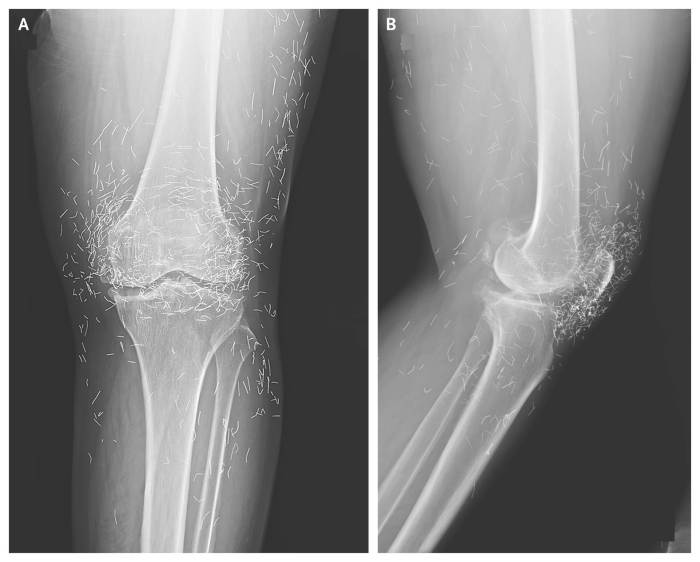X-Ray Reveals Shocking Discovery in Woman With Joint Pain
An Unexpected Find
Doctors in South Korea were stunned when a routine knee X-ray of a 65-year-old woman revealed hundreds of tiny gold needles lodged deep in her tissue. She had been battling osteoarthritis for years, a condition that erodes cartilage and bone, leaving joints stiff, swollen, and painful.
Turning to Alternatives
Standard treatments like painkillers and anti-inflammatory drugs brought little relief and instead caused stomach problems. Seeking another option, the woman turned to acupuncture — a traditional therapy that involves inserting thin needles into targeted points on the body to ease pain or treat illness.
In her case, the gold needles were intentionally left behind as part of her treatment, meant to deliver continuous stimulation to the affected areas.

A X-ray of the patient’s knee showing acupuncture needles embedded in the tissue, Photo Credit: Reddit
Risks Behind the Practice
Experts warn that leaving foreign objects inside the body is dangerous. Dr. Ali Guermazi, a radiology professor at Boston University, explained that the body reacts defensively, sparking inflammation and forming fibrous tissue around the material.
The risks don’t stop there. Needles can interfere with imaging, obscuring parts of the anatomy during X-rays. Even more concerning, patients with metal fragments in their bodies cannot undergo MRI scans. The strong magnetic force could shift the needles, puncturing blood vessels and causing life-threatening injuries.
Widespread Yet Controversial
Despite the dangers, acupuncture remains widely practiced in Asia. In South Korea and other countries, gold thread implants and needle insertions are still considered routine arthritis treatments. Supporters claim the metal provides long-term benefits, but scientific evidence is scarce.
In the U.S., acupuncture has also grown in popularity, though on a smaller scale. According to the National Institutes of Health, around 3.1 million adults and 150,000 children underwent acupuncture treatments in 2007.
A Cautionary Tale
The South Korean woman’s case, recently published in the New England Journal of Medicine, highlights the potential hazards of extreme alternative therapies. While her treatment may have been intended to help, her X-rays serve as a reminder: patients should carefully weigh the risks of unconventional practices, because what seems harmless could lead to serious complications.





